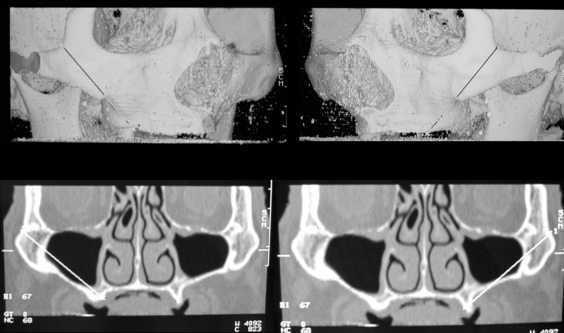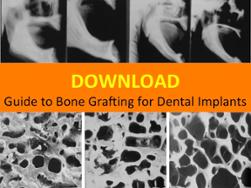Share this
What is the cost of zygomatic dental implants in Singapore?
on June 16, 2016
 Once of the common problems in oral rehabilitation with dental implants is the lack of bone in the jaw to place an implant. This is especially the case for patients who have lost all their upper teeth for a long time and have been using a removable denture for years. The pressure of a removable denture resting on the surface of the bone causes significant bone resorption. Converting to a fixed implant supported prosthesis is often impossible without resorting to reconstructive jaw surgical procedures such as bone grafting, distraction osteogenesis and even orthognathic surgery. The objective of such augmentative procedures is to “normalize” or “idealize” the jaw for placement of dental implants. However, the process is usually long drawn, requiring multiple surgeries spread over several months. The zygomatic dental implant seeks to circumvent these procedures and shorten the treatment duration and minimize the number of steps needed.
Once of the common problems in oral rehabilitation with dental implants is the lack of bone in the jaw to place an implant. This is especially the case for patients who have lost all their upper teeth for a long time and have been using a removable denture for years. The pressure of a removable denture resting on the surface of the bone causes significant bone resorption. Converting to a fixed implant supported prosthesis is often impossible without resorting to reconstructive jaw surgical procedures such as bone grafting, distraction osteogenesis and even orthognathic surgery. The objective of such augmentative procedures is to “normalize” or “idealize” the jaw for placement of dental implants. However, the process is usually long drawn, requiring multiple surgeries spread over several months. The zygomatic dental implant seeks to circumvent these procedures and shorten the treatment duration and minimize the number of steps needed.
What is the zygomatic implant?
 The zygomatic implant averages about 50mm long compared with the regular implantwhich ranges from 7mm to 15mm. This is because the bone supporting the implant is the zygoma bone ie the cheek bone and not the jaw bone. This implant enters the upper jaw, traverses the maxillary sinus and enters the zygoma bone with forms the outer roof of the sinus. This technique was introduced more than ten years ago but has not been popular until recently. More data has emerged, showing the success rates of zygomatic implants to be on par with regular implants, and has spurred a new interest in the system.
The zygomatic implant averages about 50mm long compared with the regular implantwhich ranges from 7mm to 15mm. This is because the bone supporting the implant is the zygoma bone ie the cheek bone and not the jaw bone. This implant enters the upper jaw, traverses the maxillary sinus and enters the zygoma bone with forms the outer roof of the sinus. This technique was introduced more than ten years ago but has not been popular until recently. More data has emerged, showing the success rates of zygomatic implants to be on par with regular implants, and has spurred a new interest in the system.
The limitation of the original zygomatic implant protocol
When it was first introduced, the protocol involved placing two zygomatic implants, one on each side, together with four regular implants, making a total of six implants supporting a full arch fixed prosthesis. The limitation of this protocol is that in our Asian population, most of the fully edentulous patients do not have sufficient bone to support the four regular implants. Bone grafting was still needed to reconstruct the bone in the front to place those implants. What the zygomatic implant did was merely to replace the need for a sinus bone graft. With the need for bone grafting remaining, the advantage of zygomatic implants is largely negated. Dental implants in Singapore has largely been limited to the conventional ones.
The Quad Zygomatic Implant protocol
Studies in the last few years have shown that it is possible to placed two zygoma implants on each side, ie having four zygomatic implants to support a fixed prosthesis. The data showed that success for this protocol is similar to that of regular implants. It has the added advantage of immediate restoration with a functional prosthesis, thereby shortening the treatment duration.
Cost of bone grafting and regular implants
 Cost-saving is another big advantage. By avoiding the need for bone grafting, a large part of the cost is saved. The traditional plan for a very resorbed upper jaw is to do onlay bone grafting to the front of the jaw and sinus bone grafting to the back. After waiting for 4-6 months, 6-8 implants are placed and the final fixed prosthesis is made 2-3 months later. Such a treatment plan may cost between $50000-80000 depending on the type of material used for the provisional and final prosthesis, as well as the type of bone graft material used.
Cost-saving is another big advantage. By avoiding the need for bone grafting, a large part of the cost is saved. The traditional plan for a very resorbed upper jaw is to do onlay bone grafting to the front of the jaw and sinus bone grafting to the back. After waiting for 4-6 months, 6-8 implants are placed and the final fixed prosthesis is made 2-3 months later. Such a treatment plan may cost between $50000-80000 depending on the type of material used for the provisional and final prosthesis, as well as the type of bone graft material used.
Cost of quad zygomatic implants
Using four zygomatic implants, the cost is significantly reduced. The surgery is usually done under general anesthesia but in a patient who is able to cooperate, it is possible to do this under local anesthesia with intravenous sedation in the clinic.h That will result in even greater cost-saving. When done in the clinic, cost of a full arch restoration supported by four zygoma implants ranges from $25000 to $30000. If general anesthesia is chosen, the hospital charges may add another $6000-8000 to the bill. This is a much lower cost compared with the traditional approach.
Disadvantages..
Is there still a role for the use of bone grafting and regular dental implants in rehabilitation of the atrophied maxilla? Definitely. While there are obvious advantages in the quad-zygomatic implant approach, it is not without its drawbacks. There is no contingency plan in this protocol. Should one implant fail, the whole prosthesis is compromised. Replacement of another zygomatic implant is more difficult due to limitation of the space available in the zygoma bone. The prosthesis also tends to be more bulky as the implant tends to emerge into the oral cavity through the palate.
The quad zygomatic implant method offers a more economical and time efficient way of converting a patient from a removable denture to a fixed prosthesis. While the traditional approach of bone grafting and implants has more contingencies built in, it costs more and requires a longer treatment duration.

Share this
- Jaw Surgery (93)
- Dental Implants Singapore (90)
- Orthognathic Surgery (48)
- Replacing Missing Teeth (26)
- Missing Teeth Options (23)
- Underbite (23)
- Bone Grafting (21)
- Costs (18)
- Facial Aesthetics (18)
- Aesthetics (17)
- dental implants (16)
- corrective jaw surgery (15)
- BOTOX (11)
- Dermal Fillers (11)
- Wisdom teeth (10)
- Fixed Implant Dentures (8)
- Loose Dentures Singapore (6)
- Medisave (6)
- sleep apnea (6)
- Braces (5)
- Dental Pain (5)
- Dentures in Singapore (5)
- Loose Teeth (5)
- Tooth Extraction (5)
- jaw deformities (5)
- bimax (4)
- bone graft (4)
- maxillomandibular advancement (4)
- all-on-4 (3)
- bimaxillary protrusion (3)
- chin implant (3)
- facial asymmetry (3)
- full mouth dental implants (3)
- genioplasty (3)
- immediate implant (3)
- removal of an integrated dental implant (3)
- third molars (3)
- wisdom tooth surgery (3)
- My Dentures Don't Fit (2)
- VME (2)
- bone graft healing (2)
- distraction osteogenesis (2)
- medical tourism (2)
- obstructive sleep apnea (2)
- orthodontics (2)
- plastic surgery (2)
- CT guided dental implants (1)
- Double jaw surgery (1)
- Invisalign (1)
- Periodontal Disease (1)
- Permanent Dentures Singapore (1)
- before and after photos (1)
- facial trauma (1)
- fractured dental implant (1)
- oral appliance therapy (1)
- root canal treatment (1)
- veneers (1)
- vertical maxillary excess (1)
- September 2019 (2)
- July 2019 (2)
- May 2019 (2)
- August 2018 (1)
- October 2017 (1)
- September 2017 (2)
- August 2017 (1)
- June 2017 (2)
- May 2017 (4)
- April 2017 (1)
- March 2017 (1)
- February 2017 (3)
- January 2017 (3)
- December 2016 (1)
- November 2016 (2)
- October 2016 (4)
- September 2016 (9)
- August 2016 (5)
- July 2016 (11)
- June 2016 (14)
- May 2016 (6)
- April 2016 (2)
- March 2016 (1)
- January 2016 (7)
- December 2015 (10)
- November 2015 (4)
- October 2015 (9)
- September 2015 (7)
- August 2015 (1)
- July 2015 (6)
- June 2015 (3)
- May 2015 (7)
- April 2015 (5)
- March 2015 (8)
- January 2015 (5)
- December 2014 (7)
- November 2014 (7)
- October 2014 (6)
- September 2014 (8)
- August 2014 (5)
- July 2014 (7)
- June 2014 (8)
- May 2014 (9)
- April 2014 (10)
- March 2014 (6)
- February 2014 (8)
- January 2014 (3)
Subscribe by email
Email subscription



No Comments Yet
Let us know what you think